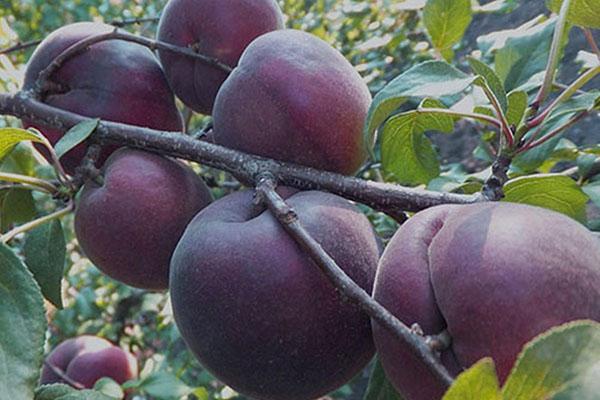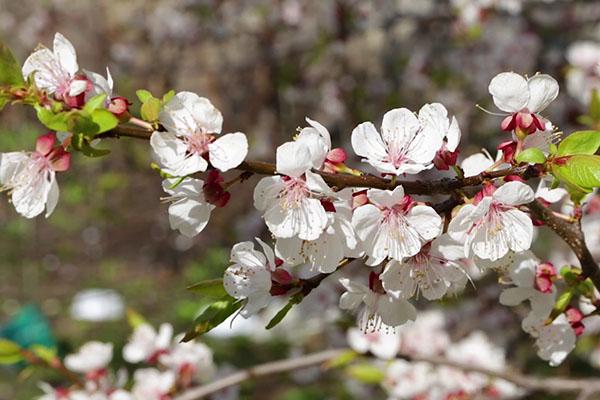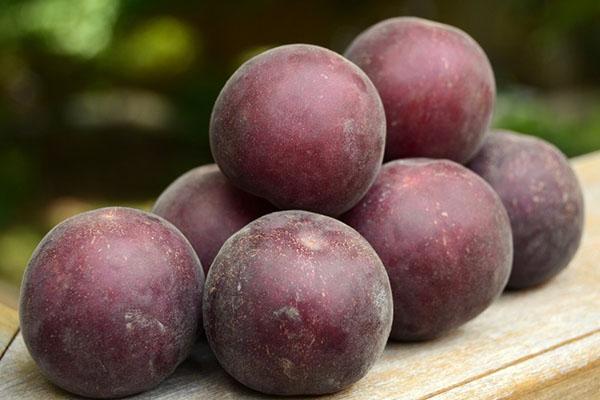A rare brunette among redheads - apricot Black velvet
 A tree with velvety, unusually dark fruits, more like a plum, does not go unnoticed. Only upon closer examination can one understand that this is an apricot Black velvet, bred by specialists from the Crimean Experimental Breeding Station.
A tree with velvety, unusually dark fruits, more like a plum, does not go unnoticed. Only upon closer examination can one understand that this is an apricot Black velvet, bred by specialists from the Crimean Experimental Breeding Station.
The variety, obtained as a result of free pollination of American black apricot, was included in the State Register for the North Caucasus in 2005. From an overseas ancestor, the plant inherited the original type of fruit, while it turned out to be quite cold-resistant and productive.
Description of apricot varieties Black Velvet

Choosing an apricot seedling, cherries, grapes or plums, the gardener reasonably pays attention to the characteristics of the variety, which include:
- ability to withstand frost;
- landing site requirements;
- the need for pollinators;
- yield indicators;
- fruit quality.
In the description of the Black Velvet apricot variety, given by the originator, it is indicated that the plant is characterized by an average growth rate, high winter hardiness and resistance to common diseases.
Although the variety is approved for cultivation in areas belonging to climate zone 5, experienced gardeners are already harvesting juicy, highly sweet fruit much further north. Culture owes its endurance cherry plumused in the breeding of dark-fruited apricots. She not only shared winter hardiness with the descendants, but also transmitted the late flowering dates.
Pinkish apricot flowers Black velvet opens when the main threat of frost has passed. This allows the trees to retain delicate flower buds and maximize healthy ovaries.
This unusual variety is characterized by medium vigor. As it matures, the tree forms a flat-round crown of medium density. It does not require special thinning. But with high yields, the branches bending under the weight need support.
 Delicious apricots with a pubescent dark purple skin ripen in the last decade of July or in the first days of August. Unusual fruits weighing about 30 g have a juicy aromatic pulp, which, when fully ripe, becomes amber-yellow, and pinkish under the blush, and a bright, truly apricot taste. Inside is a medium-sized, easily detachable bone.
Delicious apricots with a pubescent dark purple skin ripen in the last decade of July or in the first days of August. Unusual fruits weighing about 30 g have a juicy aromatic pulp, which, when fully ripe, becomes amber-yellow, and pinkish under the blush, and a bright, truly apricot taste. Inside is a medium-sized, easily detachable bone.
Apricots Black Velvet are versatile. They are quite dense, so they are suitable for transportation, they can be stored for a short time, they are good in compotes and jam, while they are incredibly tasty when fresh.
Advantages and Disadvantages of Apricot Black Velvet

For a southern culture that is demanding on heat and the amount of sun, the apricot of this variety stands out:
- excellent winter hardiness, no less than that of a hybrid plum or cherry plum;
- resistance to clasterosporium disease, bacteriosis, monilial burn and cytosporosis;
- high yield;
- excellent fruit quality.
We must not forget about the decorativeness of the tree, which in the spring is covered with a cloud of pink flowers, in the summer it yields velvety, dark purple fruits, and in the fall it becomes golden carmine.
Among the disadvantages, gardeners distinguish partial self-fertility, which is characteristic of most apricots. Therefore, for stable yields, it is necessary to plant several varieties with close flowering times on the site.They will mutually pollinate each other, and the summer resident will have tasty and healthy apricots every year.
The Black Velvet variety has medium drought tolerance. During hot periods, especially during flowering, fruit loading and autumn, when the apricot is preparing for wintering, the trees need watering.
The main disadvantage of black velvet apricots is considered by gardeners to be insufficiently large fruits, which can chop even more when the crop is overloaded, insufficient watering and nutritional deficiencies.
Planting and caring for black velvet apricots
 For apricots, they choose sunny, wind-protected places. It is important that the plant is not exposed to the risk of flooding and that the roots do not come into contact with groundwater. The planting hole must match the size of the seedling root system.
For apricots, they choose sunny, wind-protected places. It is important that the plant is not exposed to the risk of flooding and that the roots do not come into contact with groundwater. The planting hole must match the size of the seedling root system.
In order for the tree to quickly acclimatize and grow immediately, a light, loose, fertile soil with an acidity of a pH level of 7.0-7.5 is prepared for it. To do this, the garden soil is mixed with rotted compost and sand, if necessary, deoxidized with dolomite flour.
If organic matter, compost or manure must first rotate, otherwise they will burn the delicate roots of a young apricot.
At the bottom of the pit, a drainage layer is made to protect the Black Velvet apricot tree from moisture accumulation. This is especially necessary if the groundwater flows closer than 1.5–2 meters from the surface.
 The tree is placed on a mound of fertile soil poured in a hole, its roots are straightened. To prevent the seedling from being damaged by the wind, it is secured with a support dug in the middle of the planting pit. And then, raising the grafting site a few centimeters from the ground level, they fill the hole with prepared soil. The soil is rammed, the planting site is generously watered.
The tree is placed on a mound of fertile soil poured in a hole, its roots are straightened. To prevent the seedling from being damaged by the wind, it is secured with a support dug in the middle of the planting pit. And then, raising the grafting site a few centimeters from the ground level, they fill the hole with prepared soil. The soil is rammed, the planting site is generously watered.
Caring for the Black Velvet apricot after planting consists in watering, feeding and pruning the tree.
During spring feeding, fertilizers with a predominance of nitrogen or organic additives are used. This gives the plant strength for active growth, will help the apricot to gain and maintain the ovary. From the second half of summer, nitrogen is no longer needed. A mixture of phosphorus and potash fertilizers prepares the tree for wintering, allows shoots to bud and mature, strengthens the root system.
Until the tree grows strong, it is important to keep the tree trunk clean. It can be mulched with straw or cut grass. This technique will protect against moisture loss and slow down the growth of weeds.
You cannot grow a strong tree without regular pruning. Be sure to remove the root shoots, as well as weak, damaged and diseased branches. Gardeners advise starting formative pruning already in the second year of the apricot's life.